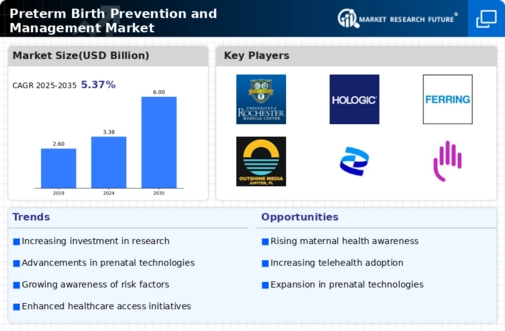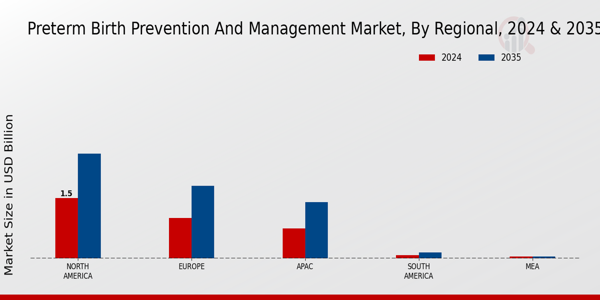Market Growth Projections
The Global Preterm Birth Prevention and Management Market Industry is poised for substantial growth, with projections indicating a market value of 3.38 USD Billion in 2024 and an anticipated increase to 6 USD Billion by 2035. This growth trajectory suggests a compound annual growth rate of 5.36% from 2025 to 2035. The increasing prevalence of preterm births, coupled with advancements in technology and heightened awareness, is expected to drive demand for effective prevention and management strategies. As stakeholders in the healthcare sector recognize the importance of addressing this issue, investments in research, technology, and education are likely to contribute to the market's expansion.
Increased Awareness and Education
Increased awareness and education regarding the risks and implications of preterm births are driving the Global Preterm Birth Prevention and Management Market Industry. Campaigns aimed at educating expectant mothers about the importance of prenatal care, nutrition, and lifestyle choices are becoming more prevalent. Organizations and healthcare providers are actively engaging in outreach programs to disseminate information on risk factors and preventive measures. This heightened awareness is likely to lead to more women seeking prenatal care and adhering to medical advice, ultimately reducing the incidence of preterm births. As a result, the market is expected to experience substantial growth in the coming years.
Government Initiatives and Funding
Government initiatives and funding aimed at reducing preterm births play a crucial role in shaping the Global Preterm Birth Prevention and Management Market Industry. Various countries are implementing programs to enhance maternal health services, provide education on prenatal care, and increase access to healthcare facilities. For example, the United States has launched initiatives to improve access to quality prenatal care for at-risk populations. Such efforts not only raise awareness but also allocate resources for research and development of effective interventions. As these initiatives gain momentum, they are likely to bolster market growth, contributing to a compound annual growth rate of 5.36% from 2025 to 2035.
Rising Prevalence of Preterm Births
The increasing prevalence of preterm births globally is a primary driver of the Global Preterm Birth Prevention and Management Market Industry. According to the World Health Organization, approximately 15 million babies are born preterm each year, accounting for about 11 percent of all live births. This alarming statistic highlights the urgent need for effective prevention and management strategies. As awareness grows regarding the complications associated with preterm births, healthcare providers and policymakers are likely to invest more in interventions aimed at reducing these rates. This trend is expected to contribute significantly to the market's expansion, with a projected value of 3.38 USD Billion in 2024.
Growing Demand for Personalized Medicine
The growing demand for personalized medicine is influencing the Global Preterm Birth Prevention and Management Market Industry. Personalized approaches to prenatal care, which consider individual risk factors and genetic predispositions, are becoming increasingly popular. Healthcare providers are utilizing genetic testing and tailored treatment plans to address the unique needs of expectant mothers. This shift towards personalized care not only enhances patient satisfaction but also improves outcomes for both mothers and infants. As the healthcare industry continues to embrace personalized medicine, the market is likely to expand, reflecting the evolving landscape of prenatal care.
Technological Advancements in Healthcare
Technological advancements in healthcare are transforming the landscape of the Global Preterm Birth Prevention and Management Market Industry. Innovations such as telemedicine, mobile health applications, and advanced diagnostic tools are enhancing prenatal care and monitoring. For instance, wearable devices that track vital signs and uterine contractions can provide real-time data to healthcare providers, enabling timely interventions. These technologies not only improve patient outcomes but also streamline healthcare delivery, making it more efficient. As these advancements continue to evolve, they are expected to drive market growth, with projections indicating a market size of 6 USD Billion by 2035.























